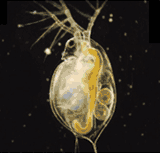SERVICE
Measurement and Analysis of Pollutants
Biotoxicity
- Biotoxicity expresses the degree of toxicity with a toxic unit (TU) on Daphnia Magna for experiment.
What is Biotoxicity Management System?
- As types of hazardous chemical substances have been rapidly increased by industrial development, it is practically very difficult to set and manage the discharge acceptance standard for every hazardous chemical substance contained in industrial wastewater.
- Accordingly, a biotoxicity management system has been introduced to make a healthy aquatic ecosystem by using organism to manage unknown hazardous chemical substances discharged through sewage and wastewater.
- Biotoxicity expresses the degree of toxicity with a toxic unit (TU) on Daphnia Magna for experiment.
What is Daphnia Magna?
- What is Daphnia Magna?

- Daphnia Magna is the primary consumer which lives in a pond and a lake widely in the world. It is a very thankful invertebrate animal that eats germs and algae to clean water.
- Its lifespan is about 50 to 60 days. Adult Daphnia Magna has normally the size of sesame seed and grows up to 5mm at maximum. On the other hand, young Daphnia Magna is very small like a dot on the paper marked with a pen. Daphnia Magna multiplies through parthenogenesis by a female alone without a male. The female lays about 5 eggs every day. Daphnia Magna has one eye and is active in water by moving with antennae.
- Why do we conduct biotoxicity test using Daphnia Magna?
The lifespan of Daphnia Magna is shorter than other organisms like bacteria, algae and fish eggs so that it multiplies easily. There are plenty of data for biotoxicity accumulated through studies. Especially, Daphnia Magna has higher sensitivity to toxicity than fish and the experiment is simple with low cost, so that it has been used widely in the world for the species of biotoxicity experiment.





